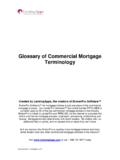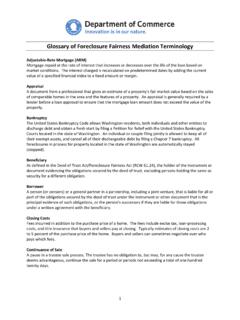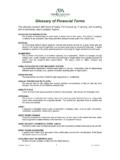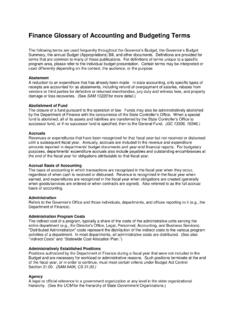Transcription of Glossary of Commercial Investment Real Estate Terms
1 CCIM Institute Page 1 of 30. 430 N. Michigan Ave., Suite 800, Chicago, IL 60611-4092; 312-321-4460; Glossary of Commercial Investment real Estate Terms A. Absorption The amount of inventory or units of a specific Commercial property type that become occupied during a specified time period (usually a year) in a given market, typically reported as the absorption rate. Accumulated cost recovery Total cost-recovery deductions taken throughout the holding period of a property. Active income Income from salary, wages, tips, commissions, and activities in which the taxpayer materially participates. Contrast with passive income. Add-on factor Calculated by dividing rentable square feet by useable square feet, the add-on factor can be used to evaluate different sites with comparable rents. Also known as load factor and rentable-to-useable ratio. Contrast with efficiency percentage. Add value Final stage of the four-stage transaction management process pertaining to a transaction manager's planning, effort, and continual contact with key decision-makers, investors, and users, as well as contact with ancillary professionals.
2 This ongoing process allows for feedback, establishes a network for problem solving, provides a means to offer additional services to the client, and enhances the transaction manager's preparedness for the next assignment. See CLOSE, MATCH, and QUALIFY. Adjusted basis The original cost basis of a property plus capital improvements, less total accumulated cost- recovery deductions and partial sales taken during the holding period. ADS Annual debt service Agglomeration economies Cost reductions or savings that result from efficiency gains associated with the concentration or clustering of firms/producers or economic activities and the formation of a localized production network. Aggregate market area gap analysis A gap analysis that is carried out for a city or several cities simultaneously to identify one or more general market areas where a positive gap exists for a particular type of Commercial real Estate . See gap analysis. Aggregation A method for estimating a functional region by combining standard formal geography units, such as zip codes.
3 Amortization The repayment of loan principal and interest through equal payments over a designated time period. Annual debt service (ADS) The total amount of principal and interest to be paid each year to satisfy the obligations of a loan contract. Annual percentage rate (APR) The true annual interest rate payable for a loan in one year taking into account all charges made to the borrower, including compound interest, discount points, commitment fees, and mortgage insurance premiums. APR also takes into account the time at which the principal is repaid (particularly payments of principal made in installments throughout the year, when interest is charged at the beginning of the year), but not the actual expenses the lender incurs in making the loan that are recharged to the borrower. Annuity Regular fixed payments or receipts over a designated time period. Appreciation An Investment 's increase in value. Copyright 2004 by the CCIM Institute.
4 All rights reserved. Version 01/04. Glossary of Commercial Investment real Estate Terms Page 2 of 30. CCIM Institute; 430 N. Michigan Ave., Suite 800, Chicago, IL 60611-4092; 312-321-4460; Appreciation potential The possibility or probability that a real Estate Investment will increase in value during the holding period. APR Annual percentage rate Assessed value The value of real property that the tax assessor establishes for the purpose of levying real Estate taxes. Assignment A transfer in which all of the tenant's leasehold interest in a property goes to another party. Nevertheless, the original tenant remains liable unless released from future obligations by the owner. Average annual effective rate The average annual effective rent divided by the total square feet. Average annual effective rent The tenant's total effective rent divided by the lease term. Averaging method A simple technique used to forecast next period's or year's vacancy rate by averaging previous yearly vacancy rates.
5 It is especially effective when vacancy rates have remained relatively flat or show little variability over time. Axial growth theory A theory of land use that builds on the concentric circle theory by adding transportation routes; it posits that while the central business district (CBD) is the most extensively used land, growth outside of the CBD. occurs along axes of transportation such as major roads or train routes. See concentric circle theory. B. Balloon payment The final payment of the balance due on a partially amortized loan . Barrier to entry An obstacle preventing a competitor from coming into the marketplace. In Terms of the real Estate market, a barrier to entry is anything that keeps developers from creating supply in the market. Barriers to entry in real Estate markets may result from geographic scarcity, uniqueness of locations, lack of access to capital markets, and land-use regulations. Barrier to growth Any hindrance to growth patterns and vectors.
6 These may be physical barriers such as a river, mountain, or limited-access highway; political barriers such as an anti-growth city council; or intangible barriers such as a perception of an area as undesirable. Base (in lease terminology ) A face, quoted, dollar amount representing the rate or rent in dollars per square foot per year and typically referred to as the base rate. Base rent The minimum rent due to the landlord. Typically, it is a fixed amount. This is a face, quoted, contract amount of periodic rent. Escalations are calculated from the annual base rate. See contract rent. Basic employment Employment that is considered to be export-oriented or export-driven, associated with activities that generate income from the sales of products and services in markets outside the local economy. Basis The total amount paid for a property, including equity capital and the amount of debt incurred. Before-tax Investment value The sum of the present values of the property to the mortgagor and mortgagee.
7 Break-even point The stage when an Investment produces an income that is just sufficient to cover recurring expenditures. For a property Investment , it is the point at which gross income equals normal operating expenses, including debt service (when the next cash flow becomes positive). Also called default point. Copyright 2004 by the CCIM Institute. All rights reserved. Version 01/04. Glossary of Commercial Investment real Estate Terms Page 3 of 30. CCIM Institute; 430 N. Michigan Ave., Suite 800, Chicago, IL 60611-4092; 312-321-4460; Breakpoint The sales threshold over which percentage rent is due. It is calculated by dividing the annual base rent by the negotiated percentage applied to the tenant's gross sales. Build-to-suit A contract in which the owner agrees to develop or finish a property or space to the specifications of the tenant. The tenant may partly carry the cost in the form of increased rent. Bulk Industrial space category that describes properties consisting of little more than four walls, a roof, and a floor.
8 They can be very large, averaging 50,000 square feet. Business risk The uncertainty associated with the possible profit outcomes of a business venture. Buy/rent threshold The point at which there is a recognizable shift of expenditure allocations away from owner- occupied housing to the rental housing market (or vice-versa) as a result of changing market conditions. C. CAM Common area maintenance CAM cap The maximum amount that the tenant pays for its share of common area maintenance costs. The owner pays any CAM expenses exceeding that amount. Cap rate Capitalization rate Capital expenditures Property improvements that cannot be expensed as a current operating expense for tax purposes. Examples include a new roof, tenant improvements, or a parking lot such items are added to the basis of the property and then can be depreciated over the holding period. They are distinguished from cash outflows for expense items such as new paint or plumbing repairs (operating expenses) that can be expensed in the year they occur.
9 See operating expenses. Capital gain Taxable income derived from the sale of a capital asset. It equals the sale price less the costs of sale, adjusted basis, suspended losses, excess cost recovery, and recapture of straight-line cost recovery. Capital market The supply and demand for resources to invest in real Estate and other investments. Capital tax Tax on a change in capital value, including capital gains tax, Estate tax, or inheritance tax. It is distinguished from a tax on income. Capitalization rate A percentage that relates the value of an income-producing property to its future income, expressed as net operating income divided by purchase price. Also known as cap rate. Cash-on-cash rate A return measure that is calculated as cash flow before taxes divided by the initial equity Investment . Cash flow The net cash received in any period, taking into account net operating income, debt service, capital expenses, loan proceeds, sale revenues, and any other sources and uses of cash.
10 Cash flow after taxes (CFAT) For properties, it is the result of several steps (see following formula), first calculating the net operating income, less mortgage and construction loan interest, less cost recovery for improvements and personal property, less amortization of loan points and leasing commissions to arrive at real Estate taxable income. Next, real Estate taxable income is multiplied by the applicable marginal tax rate to result in the tax liability (savings). Then, from the net operating income, annual debt service is subtracted to equal the cash flow before taxes (CFBT). Finally, the cash flow after taxes (CFAT) is calculated from the CFBT, less the tax liability (savings), plus Investment tax credit. The Copyright 2004 by the CCIM Institute. All rights reserved. Version 01/04. Glossary of Commercial Investment real Estate Terms Page 4 of 30. CCIM Institute; 430 N. Michigan Ave., Suite 800, Chicago, IL 60611-4092; 312-321-4460; Cash Flow Analysis Worksheet can be used to calculate a property's gross operating income, net operating income, real Estate taxable income, tax liability (savings), CFBT, and CFAT.









